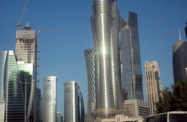Muted growth figures did not detract from a generally positive year for Qatar, in which new developments in liquefied natural gas (LNG) production were matched by broad-based expansion in non-hydrocarbons sectors.

In the first quarter of 2019, 0.9% year-on-year (y-o-y) GDP growth reflected 2018’s slowdown, while in the second quarter it contracted by 1.5% y-o-y. The World Bank estimates that Qatar’s economy grew by 0.5% in 2019, but that this will pick up to 1.5% in 2020.
This reflects a Gulf-wide trend, with overall real GDP growth among GCC states expected to have been 0.8% in 2019, down from 2% in 2018.
Low levels of growth in Qatar are attributable to various factors, among them the winding up of the infrastructure boom connected to the 2022 FIFA World Cup.
However, plans are under way to offset the slump. Under Qatar National Vision 2030, nearly QR60bn ($16.5bn) in infrastructure and real estate investments are in the pipeline over the next four years.
Meanwhile, although the effects of the ongoing economic embargo have largely been mitigated, inward foreign direct investment has decreased significantly since it was imposed.
To address this, a new draft foreign investment law was approved in 2018 and became effective in January 2019. This allows for 100% foreign ownership of companies across all economic sectors, barring some exceptions, such as banking and insurance.
Elsewhere, in a significant development that reflects a region-wide trend, April 2019 saw the merger of two of the country’s most prominent financial players, Barwa Bank and the International Bank of Qatar. The combined entity is a sharia-compliant financial institution with total assets of more than QR80bn ($22bn).
See also: The Report – Qatar 2019
Liquefied natural gas
Hydrocarbons expansion was also subdued in 2019, although this is set to change in 2020 with the expansion of the North Field, the world’s biggest non-associated natural gas field.
The expansion plans are well under way, with invitations to bid for a stake sent out to international oil firms in August. Qatar will announce which, if any, partners it plans to work with in early 2020.
Four new production facilities will help increase LNG production from the current 77m tonnes per year to 110m by 2024. Qatar is already the world’s largest exporter of LNG.
This should have a notable impact on the country’s finances, not just in the energy sector. In a report released in late August, US-based consultancy Dun & Bradstreet stated that the North Field project will provide a boost to construction as the country upgrades and expands infrastructure.
However, there are also certain headwinds to consider. Global LNG demand is waning, in part due to the US-China trade war, while supply from competitors such as the US or Australia is increasing.
Big-ticket sporting events
Despite the renewed emphasis on LNG, Qatar is continuing to pivot its economy away from hydrocarbons.
Key to these efforts has been a focus on tourism, and in particular large-scale sporting events.
The 17th edition of the biennial World Athletics Championships, organised by the International Association of Athletics Federations, was held between September 27 and October 6, 2019 in the capital Doha.
Also in Doha, the 2019 FIFA Club World Cup took place between December 11 and 21. Qatar will play host to the next instalment of the tournament in 2020, with the two events serving as warm-ups for the 2022 FIFA World Cup.
Meanwhile, in a bid to increase its air transport and logistics capacity, Qatar has directed new funds towards the upgrade of Doha’s Hamad International Airport.
Scheduled for completion in time for the World Cup, the upgraded airport will be able to accommodate more than 53m passengers per year, up from 30m currently.
Artificial intelligence and diversification
Another focus area for diversification is artificial intelligence (AI).
Qatar National Vision 2030 aims to transform the country into a knowledge-driven economy, with significant emphasis placed on both public and private digital engagement.
For example, officials aim to digitise 100% of public services by 2020, and the government is continuing in its efforts to digitalise the internal and day-to-day operations of the public sector.
In this regard, in late October the government launched the National Artificial Intelligence Strategy, a plan designed to identify economic opportunities and research potential in the burgeoning field of AI.
The launch of the strategy comes amid significant investment and activity in the broader ICT sector.
On the sidelines of the Qatar IT Conference and Exhibition, which took place in Doha from October 29 to November 1, the Ministry of Transport and Communications announced that it will extend a digital accelerator programme to support small and medium-sized enterprises (SMEs) in the country.
The programme, which is expected to begin in early 2020, aims to develop SMEs in the fields of AI, augmented reality, virtual reality and the internet of things.


